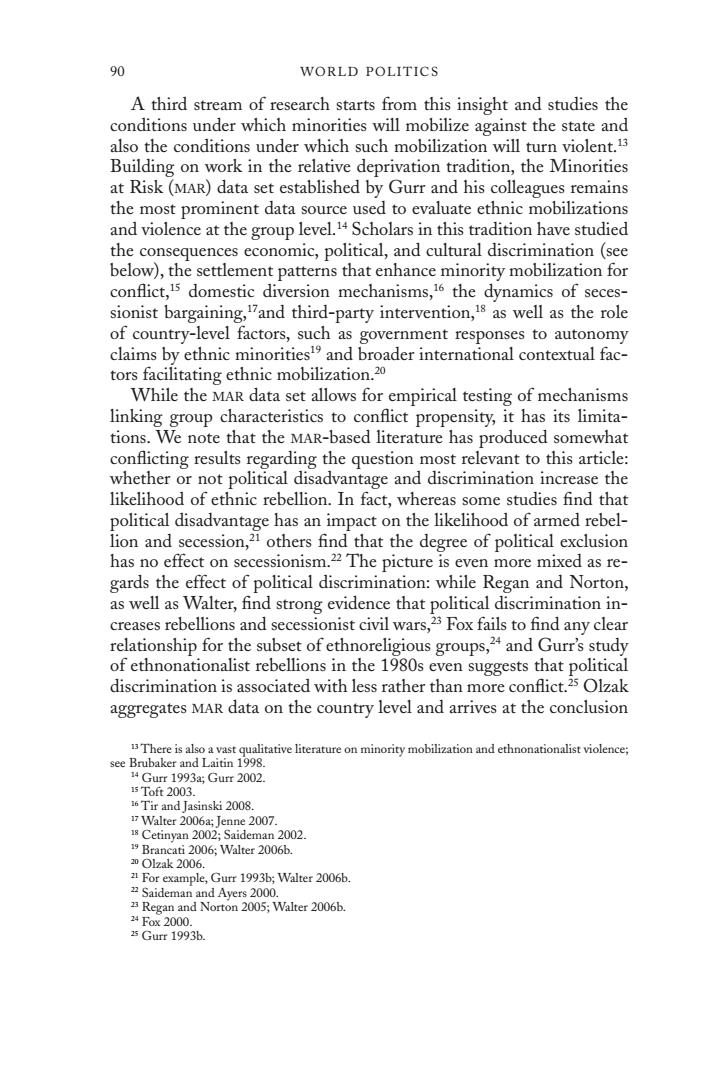正在加载图片...

90 WORLD POLITICS A third stream of research starts from this insight and studies the conditions under which minorities will mobilize against the state and also the conditions under which such mobilization will turn violent.3 Building on work in the relative deprivation tradition,the Minorities at Risk(MAR)data set established by Gurr and his colleagues remains the most prominent data source used to evaluate ethnic mobilizations and violence at the group level.4Scholars in this tradition have studied the consequences economic,political,and cultural discrimination(see below),the settlement patterns that enhance minority mobilization for conflict,15 domestic diversion mechanisms,16 the dynamics of seces- sionist bargaining,and third-party intervention,s as well as the role of country-level factors,such as government responses to autonomy claims by ethnic minorities'9 and broader international contextual fac- tors facilitating ethnic mobilization.20 While the MAR data set allows for empirical testing of mechanisms linking group characteristics to conflict propensity,it has its limita- tions.We note that the MAR-based literature has produced somewhat conflicting results regarding the question most relevant to this article: whether or not political disadvantage and discrimination increase the likelihood of ethnic rebellion.In fact,whereas some studies find that political disadvantage has an impact on the likelihood of armed rebel- lion and secession,21 others find that the degree of political exclusion has no effect on secessionism.22 The picture is even more mixed as re- gards the effect of political discrimination:while Regan and Norton, as well as Walter,find strong evidence that political discrimination in- creases rebellions and secessionist civil wars,25 Fox fails to find any clear relationship for the subset of ethnoreligious groups,2and Gurr's study of ethnonationalist rebellions in the 1980s even suggests that political discrimination is associated with less rather than more conflict.25 Olzak aggregates MAR data on the country level and arrives at the conclusion There is also a vast qualitative literature on minority mobilization and ethnonationalist violence; see Brubaker and Laitin 1998 14 Gurr 1993a;Gurr 2002. 15Toft2003. 16 Tir and Jasinski 2008. 17 Walter 2006a;Jenne 2007. Cetinyan 2002;Saideman 2002. Brancati 2006;Walter 2006b. 20Ozak2006. a For example,Gurr 1993b;Walter 2006b. 2 Saideman and Ayers 2000. Regan and Norton 2005;Walter 2006b. 24Fox2000. 25 Gurr 1993b.90 world politics A third stream of research starts from this insight and studies the conditions under which minorities will mobilize against the state and also the conditions under which such mobilization will turn violent.13 Building on work in the relative deprivation tradition, the Minorities at Risk (mar) data set established by Gurr and his colleagues remains the most prominent data source used to evaluate ethnic mobilizations and violence at the group level.14 Scholars in this tradition have studied the consequences economic, political, and cultural discrimination (see below), the settlement patterns that enhance minority mobilization for conflict,15 domestic diversion mechanisms,16 the dynamics of secessionist bargaining,17and third-party intervention,18 as well as the role of country-level factors, such as government responses to autonomy claims by ethnic minorities19 and broader international contextual factors facilitating ethnic mobilization.20 While the mar data set allows for empirical testing of mechanisms linking group characteristics to conflict propensity, it has its limitations. We note that the mar-based literature has produced somewhat conflicting results regarding the question most relevant to this article: whether or not political disadvantage and discrimination increase the likelihood of ethnic rebellion. In fact, whereas some studies find that political disadvantage has an impact on the likelihood of armed rebellion and secession,21 others find that the degree of political exclusion has no effect on secessionism.22 The picture is even more mixed as regards the effect of political discrimination: while Regan and Norton, as well as Walter, find strong evidence that political discrimination increases rebellions and secessionist civil wars,23 Fox fails to find any clear relationship for the subset of ethnoreligious groups,24 and Gurr’s study of ethnonationalist rebellions in the 1980s even suggests that political discrimination is associated with less rather than more conflict.25 Olzak aggregates mar data on the country level and arrives at the conclusion 13 There is also a vast qualitative literature on minority mobilization and ethnonationalist violence; see Brubaker and Laitin 1998. 14 Gurr 1993a; Gurr 2002. 15 Toft 2003. 16 Tir and Jasinski 2008. 17 Walter 2006a; Jenne 2007. 18 Cetinyan 2002; Saideman 2002. 19 Brancati 2006; Walter 2006b. 20 Olzak 2006. 21 For example, Gurr 1993b; Walter 2006b. 22 Saideman and Ayers 2000. 23 Regan and Norton 2005; Walter 2006b. 24 Fox 2000. 25 Gurr 1993b